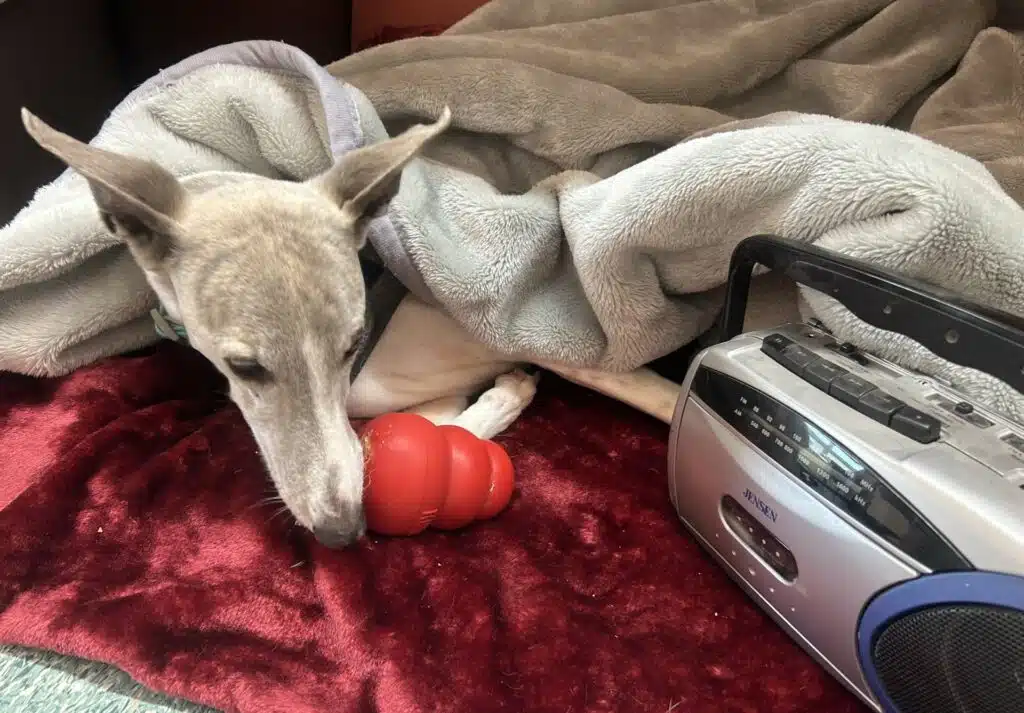How can I recognise anxiety in my pet?

In many instances, we find the dogs struggling with anxiety-related issues are also the ones suffering from a lack of confidence and low self-esteem in general as these often go together in dogs.
Self-esteem – what we see in our dog’s body language and demeanour is in direct relation to their energy levels. As a rule, dogs suffering from a lack of confidence typically appear more shy, timid, standoffish, fearful, weak and jumpy.
Dogs suffering from low levels of anxiety can easily become agitated, while high energy dog breeds or those suffering from a high level of anxiety may start redirecting their nervous energy into unhealthy obsessions or destructive behaviours. For example; engaging in self-soothing activities like chewing, pacing, hiding, looking for ways to escape and in extreme cases even performing acts of self-mutilation.
It is important to understand all the above-mentioned behaviours are compulsive actions (done without conscious thought) and performed to release the anti-stress hormones called endorphins which directly affect how well a dog can cope with stress by helping the dog to calm themselves down.
There is generally an underlying genetic predisposition in dogs presenting with fearful behaviour. The good news is fear is predominantly a learnt behaviour – what is learnt can be changed to a certain degree.
What can I do at home to help my pets?
Provide lots of mental and physical stimulation, ideally look at getting them focused on doing something else before the presence of the stimuli or before the dog has a chance to become overwhelmed.
Take your dog out for a long walk late in the afternoon and feed them their dinner in the early evening. Tired pets with full tummies are more relaxed and sleepier.
If you are truly concerned about the wellbeing of your pet due to prior experiences around this time, then please book in to see us at Halifax so we can tailor a plan that best suits your dog’s own individual needs.
If your pet has already been prescribed medication by your vet for the evening(s), please ensure they are given these at the time advised for maximum effectiveness.
- For fulltime outside four-legged family members, make sure they are housed in a secure covered area. For example: in kennel or contained in the garage with any windows covered to black out the light displays, and keep the dog safe from harm if they view these as potential escape routes in their distressed state.
- Provide your cat with a bed in a sideways cardboard box or their own carry cage and have a towel draped over the opening so it makes an effective hidey hole, do the same with pocket pets (rabbits and guinea pigs) as well, a sheet or tarp will work well in this instance.
- Keep all your animals indoors if they are classed as inside pets (remember to provide a litter tray in a low traffic area for your cat). Draw the curtains to minimize the noise and block the light displays and where possible keep your lights on in the room your pet is in.
- Another handy tip is to have the TV on or play the radio, again this will help drown out the bangs and provide a distraction. Furthermore, playing a classical music track is said to have a dramatic effect on calming cats and dogs.
- Please ensure that your cats and dogs are either wearing identification on their collar or are microchipped, so in the unfortunate event your pets do run away they can be returned home promptly.
- When your pets are scared, being calm and relaxed yourself is your greatest tool. Dogs are looking to us for some insight on how they should be reacting in situations, this is especially important if your dog is behaving nervously or fearful due to feeling insecure and/or threatened in any way.
- Denying the pet access to focus on its obsession has mixed results. In many cases, restricting access will worsen the problem by increasing anxiety or arousal. Instead, if the dog needs to pace then provide somewhere safe and secure for them to do so. If the dog needs to chew then provide the appropriate items so they can. If they feel the need to hide then allow them access to under the bed or in the back of the wardrobe.
The identification of the underlying causes of the anxiety or conflict needs to be removed. The long-term solution to this is to embark on a desensitisation and counter conditioning programme to the adverse stimulus ideally 6 months prior to the anticipated event.
How can Halifax can help my pets?
- We stock over-the-counter natural calming remedies and can book a consultation with the vet for those that need a little more to take the edge off.
- Very anxious or fearful dogs may need more powerful prescription medications.
- Thundershirt – this is a firm fitting jacket that applies gentle, constant calming pressure, like swaddling an infant child. For best results the shirt needs to be fitted at least 15 minutes before the adverse event.
- Adaptil and Feliway spray/diffuser/collar – these are a synthetic version of the dog or cat appeasing pheromone (the feel-good smell) which the mother emits to her puppies/kittens, and cats rub all over you when they mush you with their faces. It is said to have the same calming effect on adult pets in times of distress.
- Pop in and see us to discuss the best option for you and your pet or give us a call and our team can help you navigate through this often stressful and trying time for all parties concerned.

Low confidence and self-esteem in your dog is a stand-alone contributing factor that needs to be addressed at least alongside, but ideally before, you embark on any phobia behaviour modification programmes and exercises.
If you wish to pursue this behaviour modification challenge with Canine Behaviourist, Sandy Fitzgerald, please don’t hesitate to contact Halifax Vet Centre.


Recent Comments